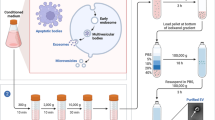Abstract
In the field of orthopaedics, autologous chondrocyte implantation is a technique currently used for the regeneration of damaged articular cartilage. There is evidence of the neo-formation of tissue displaying characteristics similar to hyaline cartilage. In vitro chondrocyte manipulation is a crucial phase of this therapeutic treatment consisting of different steps: cell isolation from a cartilage biopsy, expansion in monolayer culture and growth onto a three-dimensional biomaterial to implant in the damaged area. To minimise the risk of in vitro cell contamination, the manipulation must be performed in a controlled environment such as a cleanroom. Moreover, the choice of reagents and raw material suitable for clinical use in humans and the translation of research protocols into standardised production processes are important. In this study we describe the preliminary results obtained by the development of chondrocyte manipulation protocols (isolation and monolayer expansion) in cleanrooms for the application of autologous implantation.
Similar content being viewed by others
References
Brittberg M, Winalski CS (2003) Evaluation of cartilage injuries and repair. J Bone Joint Surg Am 85[Suppl 2]:58–69
Frenkel SR, Di Cesare PD (1999) Degradation and repair of articular cartilage. Front Biosci 4:671–685
Kuettner KE (1992) Biochemistry of articular cartilage in health ad disease. Clin Biochem 25:155–163
Gross AE (2002) Repair of cartilage defects in the knee. J Knee Surg 15:167–169
Minas T, Nehrer S (1997) Current concepts in the treatment of articular cartilage defects. Orthopedics 20:525–538
Erggelet C, Steinwachs MR, Reichelt A (2000) The operative treatment of full thickness cartilage defects in the knee joint with autologous chondrocyte transplantation. Saudi Med J 21:715–721
Nathwani AC, Benjamin R, Nienhuis AW, Davidoff AM (2004) Current status and prospects for gene therapy. Vox Sang 87:73–81
Sasaki T, Fujimoto K, Sakai K et al (2003) Gene and cell-based therapy for diabetes mellitus: endocrine gene therapeutics. Endocr Pathol 14:141–144
Brittberg M, Lindhal A, Olhlsson C et al (1994) Treatment of deep cartilage defects in the knee with autologous chondrocyte transplantation. N Engl J Med 331:889–895
Brittberg M, Peterson L, Sjogren-Jansson E et al (2003) Articular cartilage engineering with autologous chondrocyte transplantation. A review of recent developments. J Bone Joint Surg Am 85[Suppl 3]:109–115
Peterson L, Minas T, Brittberg M et al (2000) Two-to 9-year outcome after autologous chondrocyte transplantation of the knee. Clin Orthop Relat Res 374:212–234
Peterson L, Minas T, Brittberg M, Lindahl A (2003) Treatment of osteochondritis dissecans of the knee with autologous chondrocyte transplantation: results at two to ten years. J Bone Joint Surg Am 85[Suppl 2]:17–24
Giannini S, Buda R, Grigolo B et al (2005) The detached osteochondral fragment as a source of cells for autologous chondrocyte implantation (ACI) in the ankle joint. Osteoarthritis Cartilage 13:601–607
Marcacci M, Berruto M, Brocchetta D et al (2005) Articular cartilage engineering with Hyalograft C: 3-year clinical results. Clin Orthop Relat Res 435:96–105
Grigolo B, Roseti L, Fiorini M et al (2002) Applicazioni dell’ingegneria tissutale: riparazione di lesioni cartilaginee con condrociti autologhi. Reumatismo 54:364–371
— (2004) European Pharmacopoeia 5.0
EC Guide to Good Manufacturing Practice — Revision to Annex 1, “Manufacture of sterile medicinal products”
ISO 14644, “Cleanrooms and associated controlled environments”
— (1998) UNI EN 1822 “High efficiency air filter (HEPA and ULPA)”, April
ISO 14698, “Cleanrooms and associated controlled environments — Biocontamination control”
— (2001) UNI EN 12469 “Criteri di prestazione per le postazioni di sicurezza microbiologica”
Patwari P, Fay J, Cook MN et al (2001) In vitro models for investigation of the effects of acute mechanical injury on cartilage. Clin Orthop Relat Res 391[Suppl]:S61–S71
Smith RL, Carter DR, Schurman DJ (2004) Pressure and shear differentially alter human articular chondrocyte metabolism: a review. Clin Orthop Relat Res 427[Suppl]:S89–S95
Tare RS, Howard D, Pound JC et al (2005) Tissue engineering strategies for cartilage generation—micromass and three dimensional cultures using human chondrocytes and a continuous cell line. Biochem Biophys Res Commun 333:609–621
Pulsatelli L, Dolzani P, Piacentini A et al (1999) Chemokine production by human chondrocytes. J Rheumatol 26:1992–2001
Martin I, Suetterlin R, Baschong W et al (2001) Enhanced cartilage tissue engineering by sequential exposure of chondrocytes to FGF-2 during 2D expansion and BMP-2 during 3D cultivation. J Cell Biochem 83:121–128
Huch K, Stove J, Puhl W, Gunther KP (2002) Review and comparison of culture techniques for articular chondrocytes. Z Orthop Ihre Grenzgeb 140:145–152
Jayme DW, Blackman KE (1985) Culture media for propagation of mammalian cells, viruses, and other biologicals. Adv Biotechnol Processes 5:1–30
Rolleston WB (1999) Bovine serum: reducing the variables through the use of donor herds. Dev Biol Stand 99:79–86
Asher DM (1999) Bovine sera used in the manufacture of biologicals: current concerns and policies of the US. Food and Drug Administration regarding the transmissible spongiform encephalopathies. Dev Biol Stand 99:41–44
Mackensen A, Drager R, Schlesier M et al (2000) Presence of IgE antibodies to bovine serum albumin in a patient developing anaphylaxis after vaccination with human peptide-pulsed dendritic cells. Cancer Immunol Immunother 49:152–156
Shah G (1999) Why do we still use serum in the production of biopharmaceuticals? Dev Biol Stand 99:17–22
Author information
Authors and Affiliations
Corresponding author
Rights and permissions
About this article
Cite this article
Roseti, L., Serra, M., Tigani, D. et al. Cell manipulation in autologous chondrocyte implantation: from research to cleanroom. Chir Organi Mov 91, 147–151 (2008). https://doi.org/10.1007/s12306-007-0024-1
Received:
Accepted:
Published:
Issue Date:
DOI: https://doi.org/10.1007/s12306-007-0024-1




